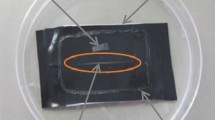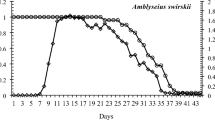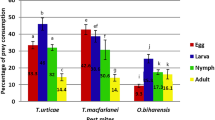Abstract
Rubber pest mites, Calacarus heveae and Tenuipalpus heveae, reach economic damage levels at the end of the rainy season and the beginning of the dry season in Brazil. Therefore, low humidity adaptation might be an important characteristic for predatory mites to successfully control pest organisms. This study determined the effect of the relative humidity (RH) levels of 30–100% on the hatching of larvae of Amblyseius acalyphus, Euseius citrifolius, Iphiseiodes zuluagai, Metaseiulus camelliae, Agistemus floridanus and Zetzellia malvinae at 25 ± 0.5 °C. These predatory mites are common on rubber trees in the state of São Paulo and might be used for introduction in the major rubber tree production regions in the state of Mato Grosso. At 70% RH or higher, viability was 70% or higher for all species, indicating that their performance might be higher during the rainy season than during the dry season. Eggs of E. citrifolius and M. camelliae presented higher viability at the lower relative humidity levels than those of other species, indicating that these species might have higher chance to persist in the dry season. It is suggested that M. camelliae should be further evaluated for introduction in the state of Mato Grosso, considering that this mite is not yet present in that area.
Similar content being viewed by others
References
B. Baier (1991) Relative humidity – a decisive factor for the use of oligophagous predatory mites in pest control F. Dusábek V. Bukuva (Eds) Modern Acarology. V. 2 AcademiaPrague and SPB Academic Publishing The Hague 661–665
F.M. Bakker M.E. Klein N.C. Mesa A.R. Braun (1993) ArticleTitleSaturation deficit tolerance spectra of phytophagous mites and their phytoseiid predators on cassava Experimental and Applied Acarology 17 97–113
Bellini M.R., de Moraes G.J. and Feres R.J.F. Plantio consorciado de seringueira (Hevea brasiliensis) com gariroba (Syagrus oleracea): uma alternativa para o controle de ácaros-praga (ACARI) da seringueira? Neotrop. Entomol., (in press).
B.A. Croft R.H. Messing J.E. Dunley W.B. Strong (1993) ArticleTitleEffects of humidity on eggs and immatures of Neoseiulus fallacis, Amblyseius andersoni, Metaseiulus occidentalis and Typhlodromus pyri (Phytoseiidae): implications for biological control on applecaneberry, strawberry and hop Exp. Appl. Acarol. 17 451–459
M.E. Courcy Williams Particlede L. Kravar-Garde J.S. Fenlon K.D. Sunderland (2004) ArticleTitlePhytoseiid mites in protected crops: the effect of humidity and food availability on egg hatch and adult life span of Iphiseius degenerans, Neoseiulus cucumeris, N. californicus, Phytoseiulus persimilis (Acari: Phytoseiidae) Exp. Appl. Acarol. 32 1–13 Occurrence Handle15139268
R.J.F. Feres (2000) ArticleTitleLevantamento e observações naturalísticas da acarofauna (AcariArachnida) de seringueiras cultivadas (Hevea spp., Euphorbiaceae) no Brasil Rev. Bras. Zool. 17 157–173
R.J.F. Feres D. de C. Rossa Feres R.D. Daud R.S. Santos (2002) ArticleTitleDiversidade de ácaros (AcariArachnida) em seringueiras (Hevea brasiliensis Muell. Arg., Euphorbiaceae) na região noroeste do Estado de São PauloBrasil Rev. Bras. Zool. 19 137–144
N.J. Ferla G.J. Moraes Particlede (2002) ArticleTitleÁcaros (ArachnidaAcari) da seringueira (Hevea brasiliensis Muell. Arg.) no Estado do Mato GrossoBrasil Rev. Bras. Zool. 19 867–888
K. Gaede (1992) ArticleTitleOn the water balance of Phytoseiulus persimilis A.-H. and its ecological significance Exp. Appl. Acarol. 15 181–198 Occurrence Handle10.1007/BF01195790
Golfari L., Caser R.L. and Moura V.P.G. 1978. Zoneamento ecológico esquemático para reflorestamento no Brasil. Série Técnica PRODEPEF 11: 66.
G.J. Moraes Particlede J.A. McMurtry (1981) ArticleTitleBiology of Amblyseius citrifolius (Acarina: Phytoseiidae) Hilgardia 49 1–29
G.J. Moraes Particlede C.A.D. da Silva A.N. Moreira (1994) ArticleTitleBiology of a strain of Neoseiulus idaeus (Acari: Phytoseiidae) from Southwest Brazil Exp. Appl. Acarol. 18 IssueID4 213–220 Occurrence Handle10.1007/BF00114168
K.J.B. Pontier G.J. Moraes Particlede S. Kreiter (2001) ArticleTitleBiology of Tenuipalpus heveae (AcariTenuipalpidae) on rubber tree leaves AcarologiaParis 41 423–427
M.W. Sabelis (1985) Development H. Helle M.W. Sabelis (Eds) Spider Mites Their Biology, Natural Enemies and Control, Vol. 1B Elsevier Amsterdam 43–53
P. Schausberger (1998) ArticleTitleThe influence of relative humidity on egg hatch in Euseius finlandicus and Typhlodromus pyri and Kampimodromus aberrans (AcariPhytoseiidae) J. Appl. Entomol. 122 497–500
M.E. Solomon (1951) ArticleTitleThe control of humidity with KOH, H2SO4other solutions Bull. Entomol. Res. 42 543–559 Occurrence Handle1:CAS:528:DyaG2cXislWisA%3D%3D
N. van Dinh M.W. Sabelis A. Janssen (1988) ArticleTitleInfluence of humidity and water availability on the survival of Amblyseius idaeus and A. anonymus (Acarina: Phytoseiidae) Exp. Appl. Acarol. 4 27–40
M.R. Vieira E.C. Gomes (1999) ArticleTitleSintomas, desfolhamento e controle de Calacarus heveae Feres, 1992 (AcariEriophyidae) em seringueira (Hevea brasiliensis Muell. Arg.) Cult. Agron. 8 39–52
Author information
Authors and Affiliations
Corresponding author
Rights and permissions
About this article
Cite this article
de Vis, R.M.J., de Moraes, G.J. & Bellini, M.R. Effect of Air Humidity on the Egg Viability of Predatory Mites (Acari: Phytoseiidae, Stigmaeidae) Common on Rubber Trees in Brazil. Exp Appl Acarol 38, 25–32 (2006). https://doi.org/10.1007/s10493-005-5444-8
Received:
Accepted:
Issue Date:
DOI: https://doi.org/10.1007/s10493-005-5444-8




